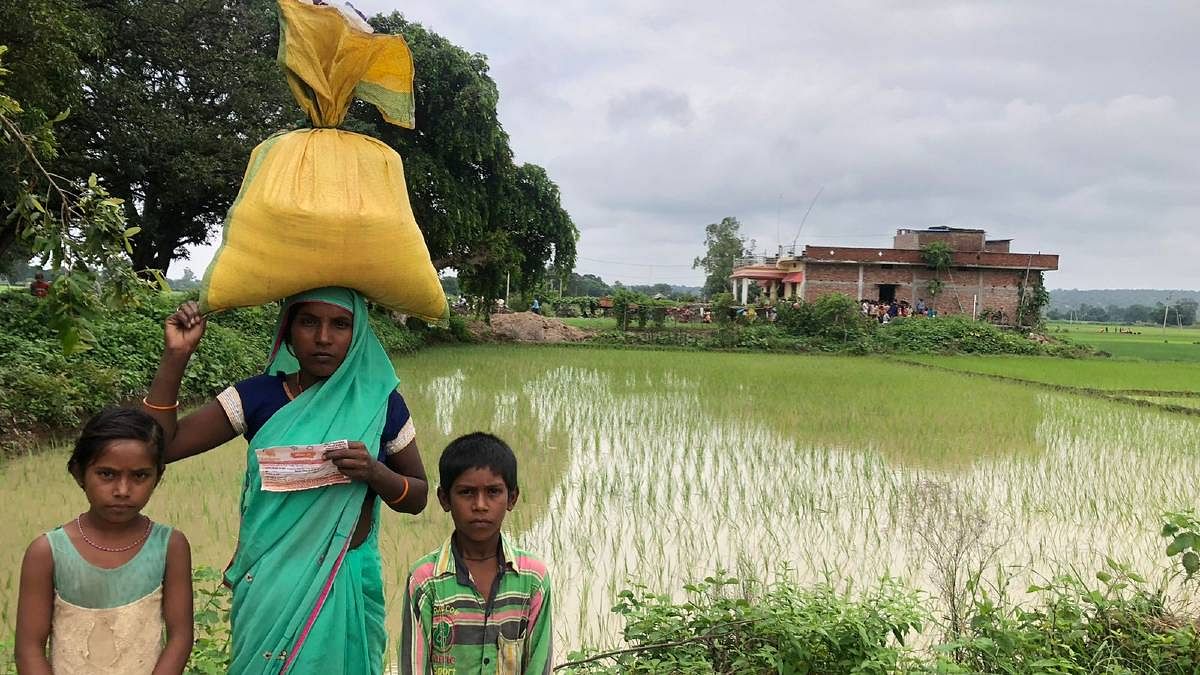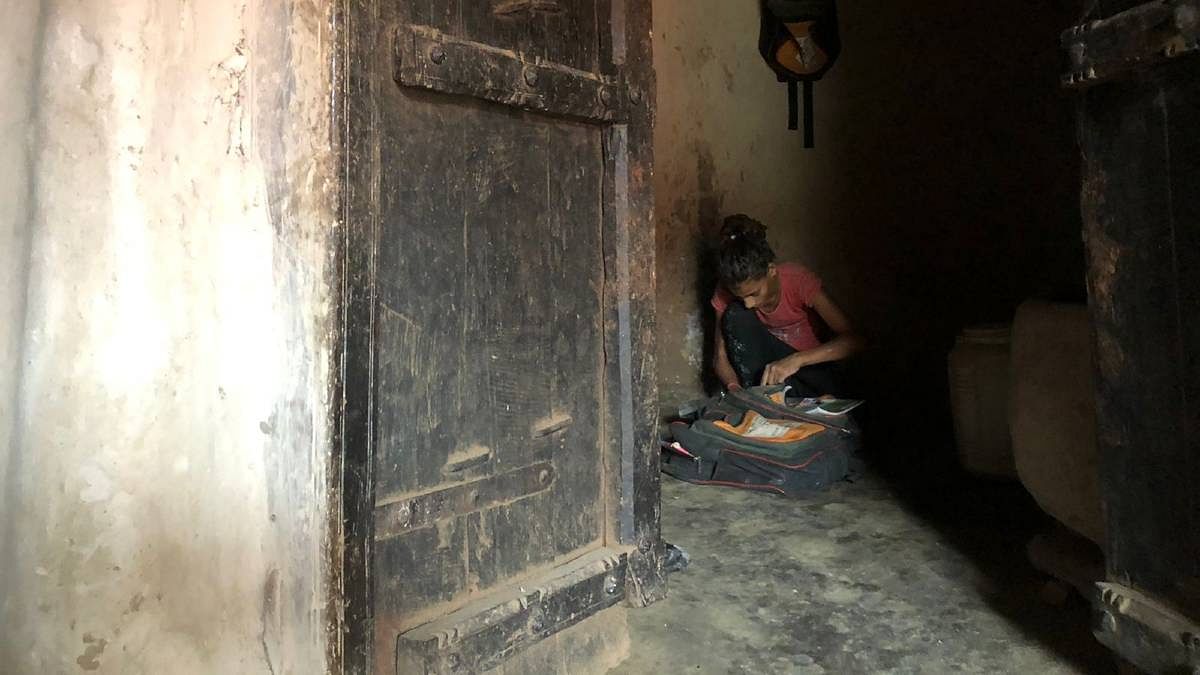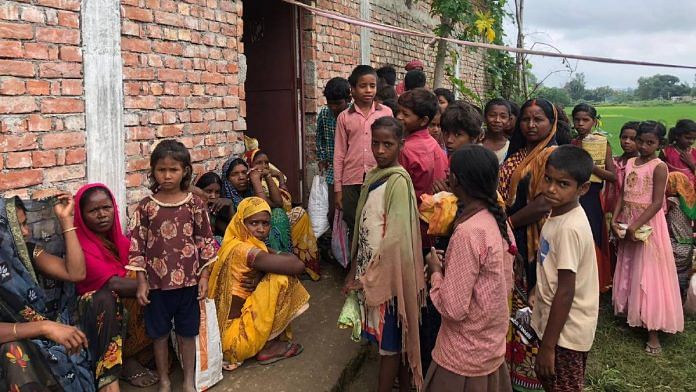Sonbadhra: Rajvanti, wife of a migrant worker in Kirhuliya village in Uttar Pradesh’s Sonbhadra district, waited outside the kotedar‘s (ration dealer) house with more than 50 other families on 10 August. Hope and desperation struggled to find place on her face as the minutes ticked by. She had been waiting for about an hour.
With her waited her two young children, son Vipin and daughter Sarita, students of Classes 3 and 4, respectively, at the government school in the village. It was the hope of being able to provide them with a satisfying meal, at least for the next few days, that was making Rajwanti anxious and restless.
The family was waiting for the dry ration that states have been providing for children ever since the Covid pandemic started, in lieu of the mid-day meal (MDM) served to students in government and government-aided schools and for those studying under various other government initiatives.
“‘We have been waiting for this dry ration for over six months now. The last time it was distributed was in November last year. I don’t even remember when the one before that was,” said Rajwanti.
As the pandemic closed down schools across the country, many children like Vipin and Sarita began missing their mid-day meals, the one time that they were assured of the few dainties that life offered them — tehri, pulses, kheer, fruits.
“Gareebi aayegi to seedhe maar pet par hi padegi. Ab roz doodh, sabzi kahan se khareed kar den (When poverty strikes, it hits the stomach. How can we buy milk and vegetables for them everyday?),” said Rajvanti.
“Most of the time during the pandemic, we have been dependent on government ration for food. But the ration for mid-day meals have been irregular and not delivered on time,” she added.
About 350 kilometres away, in Banda’s Baberu block’s Adhawan village, Sapna Yadav, a student of Class 7, had made her way to the local shop as soon she had received her third dispatch of MDM ration on 5 August. There, she sold the dry ration of rice and wheat that she and her two brothers, both students of Class 4, had received in exchange for Rs 280. She pocketed Rs 260, and gave Rs 10 each to her brothers.
Children of farmers, Sapna and her siblings had dry ration at home, but money is in short supply.
When the Covid pandemic hit the country in March last year, the central government issued directives to states and union territories to ensure the continuity of the MDM scheme and suggested the dispensation of ration, cash, or both to beneficiaries under the scheme.
Each state came up with its own plan of implementation. While UP has been providing rice, wheat and conversion money (cooking cost), others, like Haryana and Punjab, are also including pulses in the ration.
But despite efforts by the state, and the Centre’s monitoring, deliveries under the scheme have suffered.
Dr A. Laxmaiah, an epidemiologist and member of the advisory committee for the Mid-day Meal Programme, admitted that delivery of ration under the scheme has been irregular.
“Most states have performed poorly. Not getting mid-day meal ration on time will lead to further malnutrition among children in the coming year.”
Dr Laxmaiah added that even though “delivery of milk and vegetables is not feasible”, the committee had advised the provision of five items — grains, pulses, oil, millets and serum.
To ensure proper implementation, a Central official told ThePrint that in the coming days an audit team would be sent to every district across states to assess the ground level distribution. By and large, however, the Centre feels states are doing an okay job.
“There had been some delays in the beginning due to Covid lockdowns, but later states focused on the smooth delivery of dry ration. In fact, for the first time in the history of MDM, we had covered summer vacations too,” Ramchandra Meena, joint secretary, Department of School Education & Literacy, told ThePrint.
Also read: In UP’s Gorakhpur, women have taken the lead to run the family — with a little ‘self-help’
Staving hunger, ensuring school attendance
The Centre’s mid-day meal scheme was started as the National Programme of Nutritional Support to Primary Education in 1995. Some states already had the scheme at an individual level prior to this. Over the years, the central programme has seen many expansions and currently covers around 11.80 core children across the country.
Under the National Food Security Act 2013, students of Classes 1 to 8 in government and government-aided institutions are covered under the mid-day meal scheme. The scheme has two major objectives — to ensure that children’s nutritional requirements are met, and to encourage poor children to attend school more regularly.

According to MDM guidelines, every schoolchild at the primary level is entitled to 100 grams of food grain, 20 grams pulses, 50 grams of vegetables, and five grams oil daily. At the upper primary level, every child is entitled to 150 grams of foodgrains, 30 grams of pulses and 75 grams of vegetables and 7.5 grams of oil daily. The plan is that the meal should meet one-third of daily nutritional needs of these children.
During the first covid wave in April last year, Union Minister for Education Ministry Ramesh Pokhriyal announced an increase in the annual central allocation of cooking cost under the scheme, from Rs 7,300 crore to Rs 8,100 crore. This included the cooking cost.
According to sources in the ministry, the Centre has released funds worth Rs 12,882.11 crore in 2020-21, as compared to Rs 9,700.04 crore in 2019-20. The scheme is 60 per cent funded by the central government and 40 per cent by state governments.
Also read: ‘Don’t want to live like a victim’ — How a women’s adalat in UP is empowering survivors of abuse
The implementation in UP
According to central government data, Uttar Pradesh has been allocated Rs 2,07,166.14 lakh in 2021-22, as compared to Rs 118201.96 lakh in 2020-21. The scheme covers 1,86,02,791 children in the state.
From the beginning of the pandemic till now, the UP government has announced three deliveries of ration under the scheme. The first dispatch covered 76 days from March 2020 to June 2020, the second dispatch covered 49 days from July 2020 to August 2020 and the third dispatch covered 138 and 124 days (primary and upper primary) from September 2020 to February 2021.
The first batch was distributed in June, July and August of 2020. The second dispatch was distributed between October and December, 2020, and the third dispatch is being distributed in August 2021.
But a central MDM official, speaking on condition of anonymity, told ThePrint that “UP has done poorly on the MDM front”.

ThePrint found enough anecdotal accounts during its travels across three UP districts — Banda, Pratapgarh and Sonbhadra. While some families have received two installments of ration, others have received three.
In Banda’s Baberu block, the headmaster of the upper primary school there told ThePrint that so far only 70 per cent of the students have received dry ration under the scheme. “Thirty-seven students from Class 6 are still waiting for the second dispatch that they were meant to receive last year,” he said.
ThePrint reached Deepak Kumar, Principal Secretary Basic Education, UP, via calls and messages, but he said he had only recently assumed the post, and so was not in a position to answer the queries.
Meanwhile, the long wait for dry ration and the absence of the cooked meals have already started defeating one of the purposes with which the MDM was introduced — luring poor students to school. District administrations and school headmasters complain they have noticed a trend of students dropping out during the pandemic.
(Edited by Poulomi Banerjee)
Also read: How this remote, backward UP district is fighting malnutrition amid Covid pandemic



